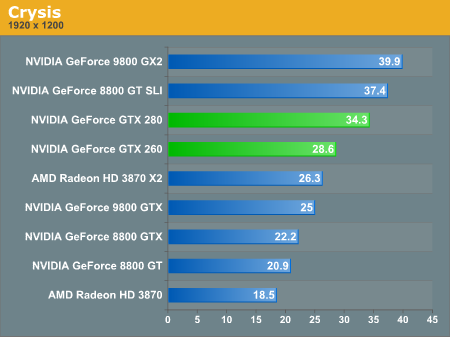Rocksta107
Limp Gawd
- Joined
- Nov 9, 2007
- Messages
- 195
If I were to trust Anand, I would think that the 280 GTX was a worse card with a worse gaming experience than the 9800 GX2 for more money! Judging by their performance curve, I would look like a moron buying a 280 GTX. Then I come over the the [H] and see that the GTX 280 blows the 9800 GX2 away. Take Crysis for example. Looking below, the 9800 GX2 is the clear winner;

Then you check the [H] graph, and lo and behold the GTX 280 is clearly showing a better experience in the game;

I think Anand has lost a lot in my views lately. I don't think the 280 GTX is what it should be for a $650 card, but it's clearly the current leader in gaming performance and Anand just fails to reach this conclusion through inferior testing methodology.
I still don't think I'll get one, and I'll at least wait for the 4800 series to come out, but if I went with Anand, I would think this was a bloody disaster!
(Sorry for the repost from Nvidia, but I think this is more relavant as a general video card post)

Then you check the [H] graph, and lo and behold the GTX 280 is clearly showing a better experience in the game;

I think Anand has lost a lot in my views lately. I don't think the 280 GTX is what it should be for a $650 card, but it's clearly the current leader in gaming performance and Anand just fails to reach this conclusion through inferior testing methodology.
I still don't think I'll get one, and I'll at least wait for the 4800 series to come out, but if I went with Anand, I would think this was a bloody disaster!
(Sorry for the repost from Nvidia, but I think this is more relavant as a general video card post)
![[H]ard|Forum](/styles/hardforum/xenforo/logo_dark.png)